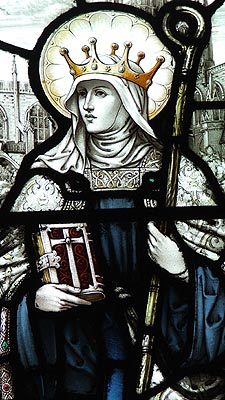
EBK Home
Kingdoms
Royalty
Saints
Pedigrees
Archaeology
King Arthur
Adversaries
Mail David
 St. Werburga
of Chester,
St. Werburga
of Chester, Abbess of Ely
(Died AD 699)
Werburga was the daughter of Wulfhere, King of Mercia, and St. Ermengilda. She was thus paternal grandaughter of the great heathen King Penda, maternal grandaughter of St. Sexburga, and nearly related to all the most famous royally born abbesses of her time.
Legend says that Wulfhere wished to promote a marriage between his daughter, Werburga, and Werbode, a powerful heathen thane and great military leader, to whose brilliant services he was much indebted. However, Werburga's brothers, Wulfad and Rufinus, objected to their sister marrying a heathen. Unable to defeat their opposition, Werbode poisoned the King's mind against his sons and obtained his authority to have them arrested for treason. Wulfhere too hastily accepted the fabricated evidence and the guiltless young men were condemned to death. No sooner were they executed than the king saw, with futile clearness, the conspiracy and treachery of which he had been the dupe. Werburga found herself set free from the Royal command to marry a heathen and, thus emboldened, she persuaded her father to never again speak of giving her to any mortal husband. She would suffer her to mourn in cloister the crime to which he had consented and of which she was the cause.
In AD 674 Wulfhere yielding to the wishes of his wife and daughter and probably supported by the counsels of St. Chad, consented with tears and regrets to part with his daughter, not to a warrior husband, but to Christ. It is probable that she was destined by her mother to be a nun and was educated as such.
No place was so fit for Werburga's novitiate as Ely, where her grandmother Sexburga was a nun and which was then ruled by her great-aunt, Etheldreda, already accounted a saint. At Werburga received a great reception at Ely, several of her kin were there with attendant lords and warriors, as well as all the men of her father's kingdom, as if attending a great wedding feast. Dressed in purple and silk and gold, Werburga went with this Royal escort on horseback and in boats to Ely. The Royal abbess, Ethelreda, with her sister, Sexburga, and a great procession of nuns and clerics came out to meet the King of the court and receive the new postulant. When the two processions met, Werburga, kneeling at the feet the venerable abbess, begged to be received. Etheldreda gladly adopted this lamb of Christ into her fold and strove to feed her faithfully.
On the death of Sexburga, Ermengilda became third abbess of Ely and appointed her daughter Werburga to succeed her as Abbess of Minster-in-Thanet. When Ermengilda died, Werburga succeeded her as fourth Abbess of Ely.
Her father's brother and successor, Aethelred, invited her to preside over the monasteries in his kingdom. She ruled over those of Weedon, Hanbury and Trentham. The church of St. John the Baptist at Chester was built for her, but it does not seem certain that she ever lived there. Once Werburga saw one of her overseers cruelly beating a man. She punished him by making his head turn right round on his shoulders. On his repentance, she prayed for him and his head returned to its proper position.
One of her most famous miracles occurred at Weedon. The lands around the monastery were infested by wild geese which devoured the crops and caused great damage. One day, when they were committing their usual depredations, Werburga drove them into a stable and left them shut up there all night. In the morning, when the door was opened, they came running to her as if asking leave to go away. She allowed them to depart in safety but charged them never again to come marauding about Weedon. They flew off, but when they had gone a short way, they returned and kept clamouring and fluttering about, until they made her understand that one of their number was nefariously detained. She found that one of her vassals had stolen and eaten the missing goose. She restored it to life and full plumage to its companions and the whole flock took their departure. No wild goose has ever dared to molest the agriculturists of Weedon since that day.
She died on 3rd February AD 699 at her own monastery of Trentham but the monks of Hanbury carried off her body to enrich their own church. In the ninth century, during the ravages of the Danes, the venerable body was removed for greater safety to the Church of SS. Peter and Paul in Chester.
Edited from Agnes Dunbar's "A Dictionary of Saintly Women" (1904).
